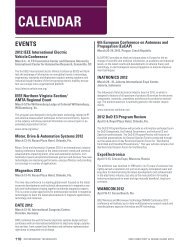2011 EMC Directory & Design Guide - Interference Technology
2011 EMC Directory & Design Guide - Interference Technology
2011 EMC Directory & Design Guide - Interference Technology
Create successful ePaper yourself
Turn your PDF publications into a flip-book with our unique Google optimized e-Paper software.
W yat t<br />
testing & test equipment<br />
actually causing problems. Often, just<br />
a few slots or seams will cause the most<br />
problems. Once the leakages are identified,<br />
you can determine the appropriate<br />
fixes with your mechanical engineer.<br />
Troubleshooting kit<br />
For speedy troubleshooting and analysis,<br />
I’ve assembled an <strong>EMC</strong> troubleshooting<br />
kit into a portable Pelican<br />
case, which can be wheeled right<br />
to an engineer’s workbench. Major<br />
contents include a small spectrum<br />
analyzer (Thurlby Thander PSA2701T,<br />
available from Newark Electronics), a<br />
broadband preamplifier (Mini-Circuit<br />
Labs or Beehive Electronics), small<br />
DIY antennas, various probes and<br />
other accessories. Other useful items<br />
for your troubleshooting kit include<br />
ferrite chokes, aluminum foil, copper<br />
tape, power line filters, signal filters<br />
and various values of resistors and<br />
capacitors. Figure 12 shows an overall<br />
view of the contents.<br />
SUMMARY<br />
In order to pass required <strong>EMC</strong> tests<br />
for radiated emissions, it is necessary<br />
to understand the basic concepts of<br />
current flow through loops, as well<br />
as differential- and common-mode<br />
currents and how they’re generated.<br />
Troubleshooting an existing design<br />
is simply the process of identifying<br />
the likely sources, determining the<br />
coupling paths through probing, and<br />
applying temporary fixes. Once these<br />
fixes have been applied and the product<br />
passes, then the electronic and<br />
mechanical engineers may determine<br />
the most cost-effective solutions. Obviously,<br />
troubleshooting or characterizing<br />
products early in the design cycle<br />
are preferred in order to reduce overall<br />
implementation costs.<br />
Figure 12. Contents of the special <strong>EMC</strong> troubleshooting kit I’ve assembled. I can probe for<br />
various RE problems, as well as test for ESD and radiated immunity. Performing these tests early<br />
in the design cycle, results in a greater chance of passing the required <strong>EMC</strong> product qualification<br />
tests.<br />
Kenneth Wyatt, Sr. <strong>EMC</strong> Engineer, Wyatt<br />
Technical Services LLC, holds degrees in biology<br />
and electronic engineering and has worked as a<br />
senior <strong>EMC</strong> engineer for Hewlett-Packard and<br />
Agilent Technologies for 21 years. He also worked<br />
as a product development engineer for 10 years at<br />
various aerospace firms on projects ranging from<br />
DC-DC power converters to RF and microwave<br />
systems for shipboard and space systems. He<br />
can be contacted at ken@emc-seminars.com. n<br />
interferencetechnology.com interference technology 21


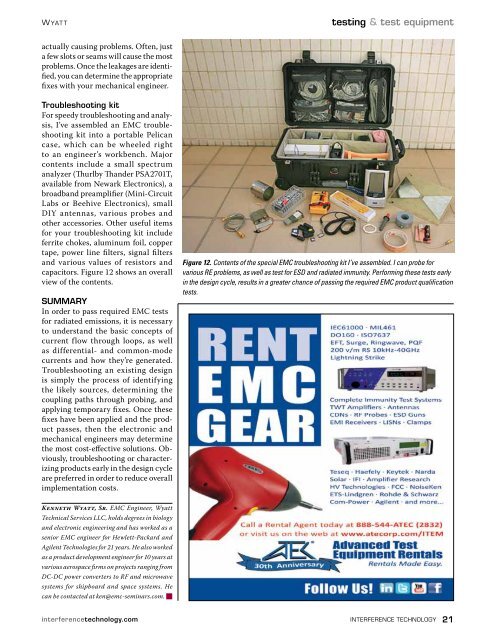

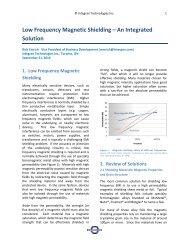

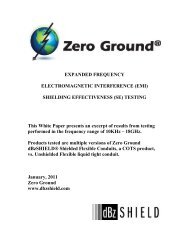
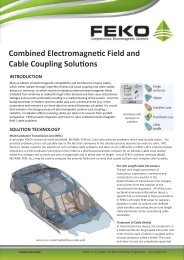

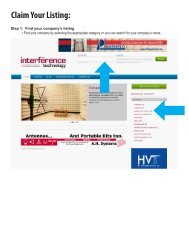

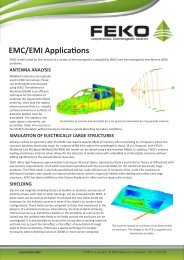
![[ thursday ] morning sessions 8:30 am-noon - Interference Technology](https://img.yumpu.com/23176841/1/190x247/-thursday-morning-sessions-830-am-noon-interference-technology.jpg?quality=85)
